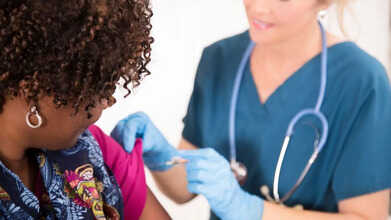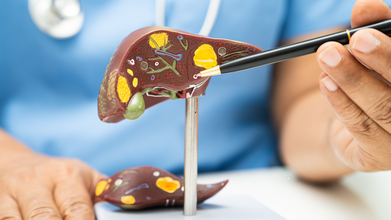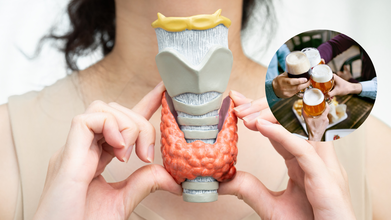- Health Conditions A-Z
- Health & Wellness
- Nutrition
- Fitness
- Health News
- Ayurveda
- Videos
- Medicine A-Z
- Parenting
How Long After a Tattoo or Piercing Can I Donate Blood?

Credits: Canva
Are you that kind of person who celebrates milestones of your life with getting a tattoo? These milestones could be anything, including the things you achieved, or the things you could not achieve but taught you a lesson. If you are this person, then you must have wondered if you can donate blood with all the tattoos on your body? There are lots of rumors on how can one donate blood, or if at all they are allowed to donate blood. So let's get into its nitty gritty!
As per American Red Cross, in most states, a tattoo is acceptable if the tattoo was applied by a state-regulated entity. Which means the tattoo artist must be licensed and must practice following all the guidelines, using sterile needles and ink that is not reused. The same is the guideline for cosmetic tattoos, which includes microblading of eyebrows. If it is done by a licensed artist in a regulated state, then it is acceptable.
However, if you got your tattoo in a state that does not regulate tattoo facilities, you must wait three months after it was applied.
The states that do not regulate tattoo facilities are:
- Arizona
- District of Columbia
- Georgia
- Idaho
- Maryland
- Massachusetts
- Nevada
- New Hampshire
- New York
- Pennsylvania
- Utah
- Wyoming
Body Piercing
Similar is the case with body piercings. It has to be done following the regulation, here the key is that the instrument used has to be a single-use equipment and disposable. Which means if you are getting it by a gun, or an earring cassette, they have to be disposable. In case you got your piercing with a reusable gun or a reusable instrument, you will be required to wait for three months.
Three-Month Wait Period
The reason behind the wait time is associated with the concerns of hepatitis, which could be easily transmitted from donors to patients through transfusion. All blood donations are thus tested for hepatitis B and hepatitis C, with several tests. However, not always are these tests are perfect, thus the three-month period is given.
What Dangers Loom Over?
Donating blood after getting a tattoo can be dangerous as unclean tattoo needle could carry bloodborne viruses, which are hepatitis B, hepatitis C and HIV. In 2020, the Food and Drug Administration (FDA) updated its guideline, making the wait time shorter from one year to three months. This is because if you contract a bloodborne illness, it could be detectable within the period of 3 months.
What else makes you ineligible to donate blood?
There are other reasons why you may not be allowed to donate blood. As per the American Red Cross, you are not allowed to donate blood if you have
- hepatitis B or C
- HIV
- Chagas disease, which is a parasitic infection that kissing bugs cause
- leishmaniasis, a parasitic infection that sand flies cause
- Cruetzfeldt-Jakob Disease (CJD), a rare disorder that leads to mental deterioration
- Ebola virus
- hemochromatosis, which means extreme build up of iron
- hemophilia
- jaundice
- sickle cell disease
As per the National Institutes of Health (NIH) Blood Bank, these conditions make you permanently ineligible from donating blood.
While there are certain conditions that makes your permanently ineligible, there are other conditions that makes you temporarily ineligible from donating blood. These include:
- If you have a bleeding condition, and have issues with your blood clotting
- If you have received transfusion from a person
- If you have cancer. Here, the eligibility depend son the type of cancer you have
- If you have recently underwent a dental or oral surgery. In such a case, you would have to wait for three days
- If you had a recent heart attack, heart surgery or angina. You must wait for 6 months
- If you are pregnant, you can only donate blood after 6 months after delivering your child
Flu Shot: Will Getting Vaccinated Twice This Year Boost Immunity?

Credits: Canva
As flu season approaches, many people wonder whether getting vaccinated twice in the same year might offer extra protection. With immunity known to fade and flu viruses changing fast, the question sounds reasonable. But according to public health experts, doubling up on flu shots rarely delivers added benefit for adults.
Flu Shot: Why a Second Flu Shot Usually Does Not Help
There is no known harm in receiving two flu shots in one year, but research shows it is largely unnecessary. Katrine Wallace, an epidemiologist at the University of Illinois at Chicago, explains that most adult immune systems have already been exposed to both the influenza virus and the vaccine over the years.
Because of this prior exposure, studies have not found improved protection from a second flu shot, even among older adults whose immune responses may be weaker. For the majority of people, one influenza vaccination per year is sufficient to reduce the risk of severe illness and complications.
The guidance is different for children. The US Centers for Disease Control and Prevention recommends that children under the age of nine who have never received a flu vaccine should get two doses during their first vaccination season to build adequate immunity.
Flu Shot: Why You Still Need a Flu Shot Every Year?
While a second shot in the same season does not add much value, annual vaccination remains important. Flu viruses mutate quickly, far faster than viruses like Covid. This means last year’s vaccine is less effective against the strains circulating this season.
In addition, immunity from the flu shot gradually declines over time. These two factors make yearly vaccination necessary, even for people who rarely fall sick.
Flu Shot: Which Flu Vaccine Should Children Get?
As per CDC, there are two kinds of influenza vaccines in use. One is the injectable vaccine commonly known as the flu shot. The other is given as a nasal spray.
This year, all flu vaccines approved for children are designed to protect against three strains of the virus, including two influenza A strains and one influenza B strain. During any flu season, several types of flu viruses can circulate at the same time, and in some cases, these viruses may shift or evolve as the season progresses.
Flu Shot: Timing Matters More Than Taking Two Shots
Experts also stress that when you get the flu shot matters almost as much as getting it at all. Wallace notes that vaccination in August or early September is generally not advised for most adults, since protection may weaken before flu activity peaks.
There are exceptions. Pregnant people in their third trimester may be advised to get vaccinated earlier to pass antibodies to their baby, who cannot receive a flu shot immediately after birth, as per the CDC.
For most adults, the best approach is simple: get one flu shot per year and get it at the right time. There is no need to worry about doubling doses unless advised by a doctor. One well-timed vaccination remains the most effective and evidence-backed strategy
Nebokitug Explained: Antibody Used To Treat A Rare Liver Disease

Credits: Canva
For people living with primary sclerosing cholangitis or PSC, medical options have always been painfully limited. Until now, there has been no approved drug that can slow the disease itself. Treatment has mostly meant managing symptoms and waiting, often for years, until a liver transplant becomes the only option. That is why new results around a monoclonal antibody called nebokitug are being seen as a turning point.
Researchers from the University of California Davis have reported promising findings from a Phase 2 clinical trial showing that nebokitug appears safe and may actually reduce liver inflammation and scarring. The study was published in the American Journal of Gastroenterology and has brought cautious optimism to both doctors and patients.
What Exactly Is PSC?
PSC is a rare, long-term liver disease that mainly affects the bile ducts. These ducts act like tiny pipelines that carry bile from the liver to the small intestine, where it helps digest fats. In PSC, these ducts become inflamed, damaged, and scarred over time. As they narrow, bile starts backing up in the liver, slowly causing liver injury.
Many people with PSC also have inflammatory bowel disease, especially ulcerative colitis. This strong link has led researchers to believe that ongoing gut inflammation may trigger immune reactions that damage the liver as well. Symptoms can range from extreme tiredness and itching to yellowing of the skin and eyes. Some patients have no symptoms at all in the early stages, which makes the disease harder to catch.
Why Treatment Has Been So Difficult
One of the biggest challenges with PSC is that doctors have not had a way to stop the scarring process itself. Once fibrosis sets in, it slowly progresses and increases the risk of liver failure and bile duct cancer. While medications can help with itching or infections, they do not change the course of the disease. This gap in treatment is what makes the nebokitug study so important.
How Nebokitug Works
Nebokitug is a lab-made antibody designed to block a protein called CCL24. This protein plays a key role in driving inflammation and fibrosis in the liver. In people with PSC, CCL24 levels are higher than normal and are found around the bile ducts where damage is most severe.
By blocking CCL24, nebokitug aims to calm the immune response and slow down the scarring process. Earlier lab and animal studies suggested this approach could work. The new trial is one of the first to test this idea in people with PSC.
What the Trial Found
The Phase 2 study included 76 patients from five countries. Participants received either one of two doses of nebokitug or a placebo through an IV every three weeks for 15 weeks. The main goal was to check safety, since this was still an early-stage trial.
The results were encouraging. Nebokitug was found to be safe and well tolerated. More importantly, patients who already had more advanced liver scarring showed improvements in liver stiffness and markers linked to fibrosis when compared to those on placebo. These changes suggest that the drug may be doing more than just easing symptoms.
Experts involved in the study say these findings could change the future of PSC care. Reducing inflammation and fibrosis could slow disease progression and delay or even prevent the need for a transplant in some patients. While larger trials are still needed, nebokitug represents one of the strongest signals yet that PSC may finally have a disease-modifying treatment on the horizon.
Can Drinking Beer Cause Cancer? A New Study Says There Is No Safe Limits

Credits: Canva
Now, drinking beer too could increase the risk of mouth cancer. On Tuesday, researchers at the Tata Memorial Centre (TMC) reported this adding new evidence. They found a 59 per cent higher risk of mouth cancer in people who drank, on average, just two grams of alcohol from beer daily, compared with those who did not drink. The research suggests that there may not be any safe limit to drink.
What Did The Study Reveal About Beer And Cancer?
Their study in India's large scale analysis that probs link between alcohol and cancer of the buccal mucosa. This is the pink lining of cheeks and lips. In India, this kind of cancer is the second most common malignancy in India after breast cancer. It also leads to 1,40,000 new cases and nearly 80,000 deaths each year.
Who Are More Prone To Buccal Mucosa Cancer?
People who consume more than one glass of alcohol a day and chew tobacco on a day to day basis are five times more at risk of developing this cancer as compared to those who do not drink or chew tobacco.
The findings of the study was published in the journal BMJ Global Health and it suggests that joint use of both, alcohol and tobacco leads to 62 per cent of all buccal mucosa cancer in the country.
As Telegraph reported, Tata Memorial Centre for Cancer Epidemiology unit's head of molecular epidemiology and population genomics unit Sharayu Mhatre said, "We see an unmistakable pattern: the more alcohol people drink, the greater their risk of buccal mucosal cancer."
Buccal mucosal cancer continues to pose a serious public health challenge in India. Among 100 patients diagnosed with locally advanced stages of the disease, 57 die within five years, a mortality rate that experts say highlights the urgent need for prevention, early detection, and stronger regulation of risk factors.
Alcohol Emerges as a Major Risk Factor
While the link between alcohol and cancer is well known, new findings reinforce just how dangerous alcohol consumption can be for oral health. Researchers found that people who consumed alcohol had a 68% higher risk of developing buccal mucosal cancer compared to non-drinkers.
What stood out most was the type of alcohol consumed. Unregulated, locally brewed liquor carried the highest risk, increasing cancer likelihood by 87%, compared to 72% among consumers of regulated, commercially sold drinks. Experts point out that these local brews often contain significantly higher ethanol concentrations and lack quality control.
Not Just Heavy Drinking—Even Small Amounts Matter
The study analyzed drinking patterns among over 3,700 participants, comparing cancer patients with healthy individuals. Alcohol types ranged from beer and spirits like whisky and vodka to traditional local drinks such as bangla and tharra. Ethanol levels varied widely—from 5% in beer to as high as 90% in some locally distilled spirits.
Alarmingly, increased cancer risk was seen even at low levels of alcohol intake. As little as two grams of alcohol a day from beer, or roughly one glass of stronger liquor, was enough to raise concern.
Alcohol and Tobacco: A Dangerous Combination
The risk escalates dramatically when alcohol use is combined with tobacco chewing. Tobacco alone raised cancer risk by 200%, alcohol alone by 76%, but together, the risk shot up to 346%. Researchers explain that alcohol may damage the mouth’s protective lining, making it easier for tobacco-related carcinogens to penetrate and cause harm.
Health experts stress that these findings underline the need for greater public awareness, stricter monitoring of locally brewed alcohol, and stronger prevention strategies. The World Health Organization has already warned that no level of alcohol is safe, noting that even light or moderate drinking contributes to a significant number of alcohol-related cancers globally.
For India, where oral cancers remain widespread, these insights serve as a critical reminder: everyday habits can have life-altering consequences.
© 2024 Bennett, Coleman & Company Limited

